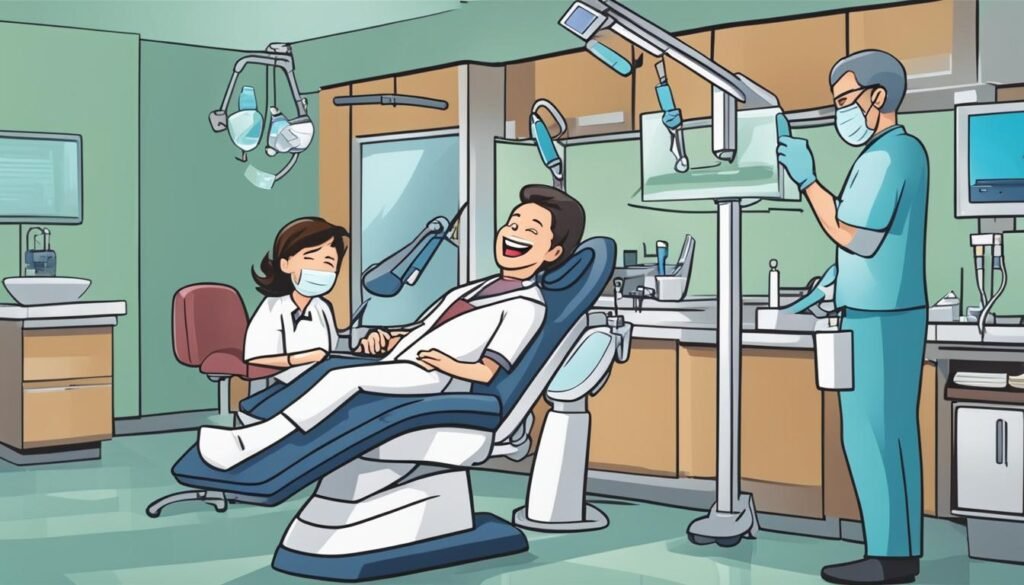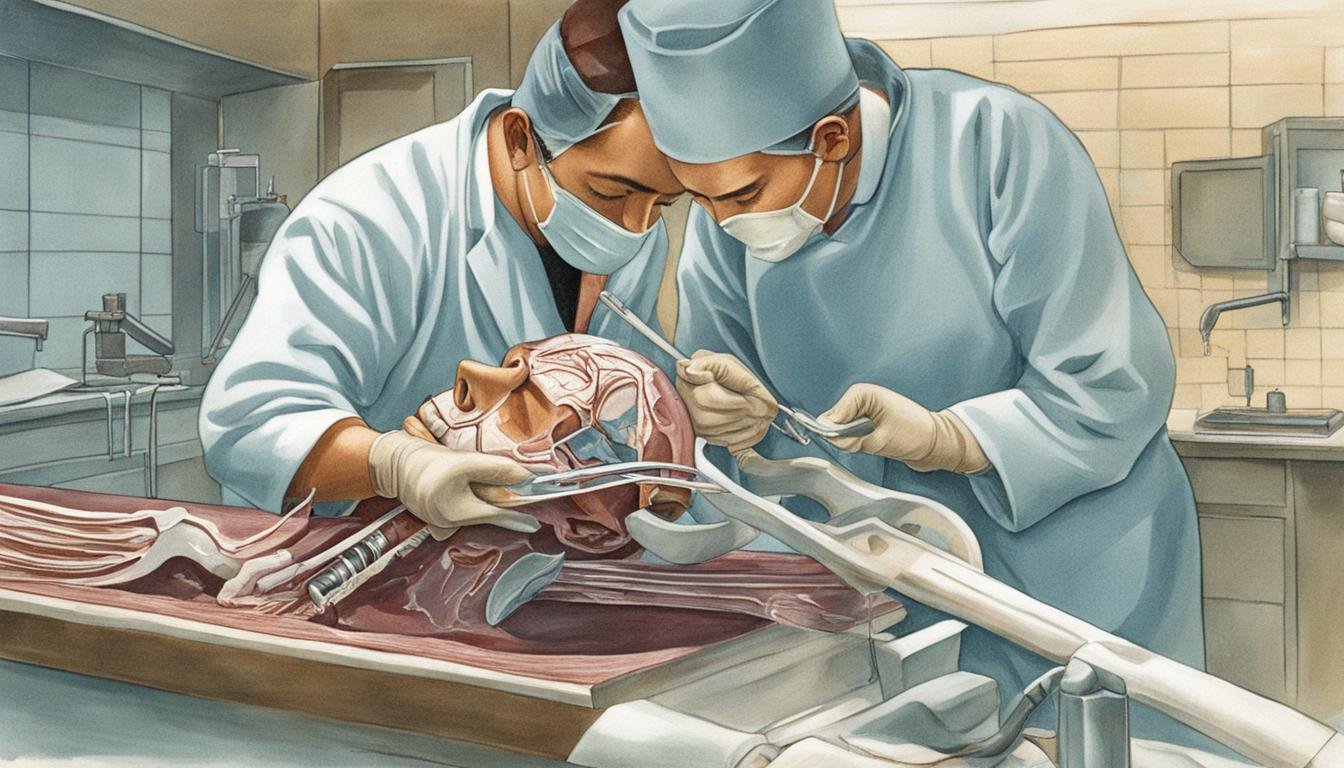Alveoloplasty is a surgical procedure that reshapes and smoothes out the jawbone following tooth extraction or loss. Also known as jawbone contouring, it is performed to create a level surface in the mouth for tooth replacements such as dentures, bridges, or implants. Whether done at the time of tooth extraction or after the site has fully healed, alveoloplasty aims to prepare the mouth for successful tooth replacements and improve overall oral health.
Key Takeaways:
- Alveoloplasty is a surgical procedure that reshapes and smoothes the jawbone.
- It is performed to create a level surface for tooth replacements like dentures, bridges, or implants.
- The procedure can be done at the time of tooth extraction or after the site has fully healed.
- Alveoloplasty helps in promoting successful healing after tooth extraction.
- It reduces the risk of complications associated with ill-fitting restorations.
Why Would You Need an Alveoloplasty Procedure?
An alveoloplasty procedure is necessary when a tooth is extracted, and the healing process results in an uneven or bumpy area in the jawbone called an edentulous ridge. This ridge may not provide a suitable foundation for a replacement tooth, such as a denture, bridge, or implant, leading to an ill-fitting restoration. The purpose of an alveoloplasty is to smooth out the jawbone, creating a better fit for the tooth replacement and improving stability and comfort for the patient.
Alveoloplasty also plays a vital role in promoting successful healing after tooth extraction and reduces the risk of complications associated with tooth replacements. By reshaping and contouring the jawbone, the procedure helps ensure that the subsequent restoration fits accurately in the mouth and functions optimally. Whether performed at the same time as tooth extraction or separately, an alveoloplasty can significantly enhance the overall outcome of tooth replacement procedures.
Furthermore, alveoloplasty offers the benefit of improved oral health. By creating a level surface in the jawbone, it facilitates better oral hygiene practices and reduces the accumulation of bacteria and debris. This, in turn, helps prevent oral health issues such as gum disease and tooth decay, promoting the long-term health and longevity of the tooth replacement.
Why Would You Need an Alveoloplasty Procedure?
The Alveoloplasty Procedure: Steps and Recovery
An alveoloplasty procedure involves a series of steps to reshape and smooth out the jawbone. The process begins with the patient receiving local anesthesia to ensure a pain-free experience. Once numb, the dentist makes an incision at the gumline to expose the jawbone. Specialized tools like a chisel or burr are then used to carefully adjust and reshape the bone to the desired contour.
After the jawbone has been reshaped, the gum tissue is stitched back together, allowing for proper healing. The patient will receive specific post-operative instructions, such as eating soft foods and practicing good oral hygiene, to ensure a smooth recovery. It’s normal to experience some soreness after the procedure, but over-the-counter pain medications can help manage any discomfort.
The healing period for alveoloplasty can take several weeks. During this time, it’s important for patients to follow their dentist’s instructions and attend any follow-up appointments. Swelling is expected to subside within 48 hours, and stitches are typically removed within a week to ten days. It’s crucial for patients to take proper care of their oral health during the recovery period to ensure the best possible outcome.
Benefits and Risks of Alveoloplasty
Alveoloplasty, also known as jawbone contouring, offers several benefits to patients who require tooth replacements such as dentures, bridges, or implants. By reshaping and smoothing out the jawbone, this surgical procedure creates a level surface that enhances the fit and stability of the restorations. The improved fit leads to increased comfort and functionality, allowing patients to enjoy their daily activities without any discomfort.
Moreover, alveoloplasty promotes successful healing after tooth extraction and reduces the risk of complications associated with ill-fitting restorations. By creating a smooth jawbone contour, it reduces the chances of food debris or bacteria getting trapped in uneven surfaces, which could lead to infections or gum diseases. Additionally, the procedure contributes to better oral health by facilitating proper dental hygiene practices, such as brushing and flossing, which can be more effective on a level surface.
Reducing Risks
While alveoloplasty offers numerous benefits, it is important to consider and understand the potential risks associated with the procedure. Like any surgical intervention, there can be some complications, although they are generally rare and manageable. Possible risks include excessive bleeding during or after the surgery, infection at the surgical site, reopening of stitches, and temporary numbness or tingling in the surgical area.
However, patients can mitigate these risks by following the post-operative care instructions provided by their dentist. It is crucial to maintain good oral hygiene, adhere to a soft food diet during the recovery period, and take any prescribed medications as directed. If patients experience any concerning symptoms or complications, it is essential to promptly consult their dentist for proper evaluation and guidance.

Alveoloplasty: A Step Towards a Confident Smile
For individuals seeking tooth replacements, alveoloplasty is a vital step towards achieving a confident smile. The procedure’s ability to reshape the jawbone and create a level surface ensures that dentures, bridges, or implants fit securely and comfortably in the mouth. With improved stability and a natural appearance, patients can enjoy the benefits of a functional and aesthetically pleasing dental restoration.
As with any surgical procedure, it’s important to understand the potential risks and benefits before undergoing alveoloplasty. Although complications are rare, they can include excessive bleeding, infection, or numbness in the surgical area. Following post-operative care instructions and maintaining good oral hygiene are essential for a successful recovery and long-term oral health.
To learn more about alveoloplasty or to schedule a consultation, contact your local dental practice. Their team of experienced professionals can provide the guidance and expertise needed to determine if alveoloplasty is the right solution for your tooth replacement needs.
Conclusion and Contact Information
Alveoloplasty is a highly beneficial surgical procedure that can greatly improve the fit, stability, and comfort of tooth replacements such as dentures, bridges, or implants. By reshaping and smoothing out the jawbone, alveoloplasty creates a level surface that promotes successful healing and reduces the risk of complications. It is an essential step in preparing the mouth for optimal tooth replacement outcomes.
If you have any questions about alveoloplasty or would like to schedule a consultation, we encourage you to reach out to your local dental practice. Our team of experienced dental professionals will be happy to provide you with the information and guidance you need. Don’t hesitate to take the next step towards achieving your ideal smile with alveoloplasty.
Contact us today to learn more about the benefits of alveoloplasty and how it can improve your oral health and quality of life. We’re here to help you regain your confidence and enjoy the comfort and functionality of well-fitted tooth replacements.
FAQ
What is alveoloplasty?
Alveoloplasty is a surgical procedure that reshapes and smoothes out the jawbone following tooth extraction or loss.
What is the purpose of an alveoloplasty procedure?
The purpose of an alveoloplasty is to create a level surface in the mouth for tooth replacements such as dentures, bridges, or implants, improving their fit and stability.
When is alveoloplasty performed?
Alveoloplasty can be done at the time of tooth extraction or after the site has fully healed, depending on the individual’s specific needs.
How is the alveoloplasty procedure performed?
The procedure involves making an incision at the gumline, adjusting and reshaping the jawbone using specialized tools, and then stitching the gum tissue for proper healing.
How long does it take to heal after alveoloplasty?
The healing period typically takes several weeks, but the average time from alveoloplasty to tooth replacement ranges from 23 to 65 days.
What are the benefits of alveoloplasty?
Alveoloplasty improves the fit and stability of tooth replacements, promotes successful healing, and reduces the risk of complications associated with ill-fitting restorations.
What are the risks of alveoloplasty?
Risks may include excessive bleeding, infection, reopening of stitches, and numbness or tingling in the surgical area. It is important to follow post-operative care instructions and consult a dentist if any complications arise.
How much does an alveoloplasty procedure cost?
The cost can vary depending on factors such as overall oral health, complexity of the case, and the dental practice. On average, the cost ranges from $500 to $2000.
Is alveoloplasty covered by dental insurance?
Alveoloplasty may be partially or fully covered by dental insurance if it is deemed medically necessary. It is advisable to consult with a dentist to discuss financial considerations.
How does alveoloplasty prepare the mouth for tooth replacements?
Alveoloplasty reshapes and smoothes the jawbone, creating a level surface that enhances the fit, stability, and comfort of dentures, bridges, or implants.
Where can I find more information or schedule a consultation?
Patients can contact their local dental practice or the specified dental professional mentioned in the sources for more information or to schedule a consultation.

